
Prince William Forest Park was established as Chopawamsic Recreational Demonstration Area in 1936. Its location is in Triangle, Virginia, adjacent to the Marine Corps Base Quantico. The park is the largest protected natural area in the Washington, D.C. metropolitan region at over 16,000 acres (6,500 ha). Today, the park is a window into the past and serves as an example of what much of the East Coast once looked like centuries ago.

Greenport is the terminus of the Main Line of the Long Island Rail Road. It is officially located at Wiggins Street and Fourth Street in the Village of Greenport, New York, although the property spans as far east as 3rd Street and the Shelter Island North Ferry terminal.

The Upper Nyack Snowshoe Cabin, built in 1926 in Glacier National Park, is a significant resource both architecturally and historically as a shelter, usually 8–12 miles apart, for patrolling backcountry rangers. The design is similar to that used in Yellowstone National Park, which was in turn adapted from U.S. Forest Service shelters, which were themselves adaptations of trapper cabins. Upper Nyack retains some original interior furnishings, including hanging beds.

The Pass Creek Snowshoe Cabin, built in 1938 in Glacier National Park, is a significant resource both architecturally and historically as a shelter, usually 8–12 miles apart, for patrolling backcountry rangers.

The Ford Creek Patrol Cabin in Glacier National Park was built in 1928. The National Park Service Rustic log structure was a significant resource both architecturally and historically as a network of shelters, approx. one day's travel apart, for patrolling backcountry rangers.

The Upper Logging Lake Snowshoe Cabin was built in 1925 in Glacier National Park. The National Park Service Rustic as a shelter for rangers patrolling the backcountry. The design is similar to that used in Yellowstone National Park, which was in turn adapted from U.S. Forest Service shelters, which were themselves adaptations of trapper cabins.
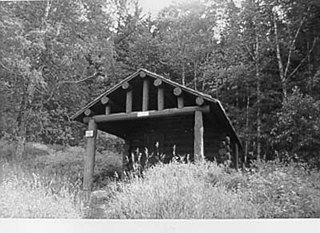
The Upper Kintla Lake Patrol Cabin in Glacier National Park is a rustic backcountry log cabin. Built in 1931 to standard National Park Service plan G913, the cabin has a single room. The cabin was modeled after similar cabins used at Yellowstone National Park, which were in turn similar to those used by the U.S. Forest Service, which resembled trappers' cabins. The Upper Kintla Lake Patrol Cabin is actually situated on the eastern shore of Kintla Lake which is almost 2 miles (3.2 km) west of Upper Kintla Lake.

Upper Windy Creek Ranger Cabin No. 7, also known as the Upper Windy Patrol Cabin is a log shelter in the National Park Service Rustic style in Denali National Park. The cabin is part of a network of shelters for patrolling park rangers throughout the park. It is a standard design by the National Park Service Branch of Plans and Designs and was built in 1931.
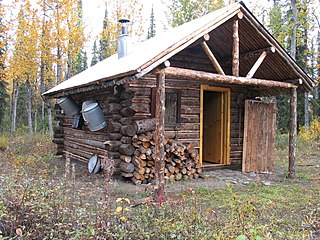
The Lower East Fork Ranger Cabin No. 9, also known as the Lower East Fork Patrol Cabin, is a log shelter in the National Park Service Rustic style in Denali National Park. The cabin is part of a network of shelters used by patrolling park rangers throughout the park. It is a standard design by the National Park Service Branch of Plans and Designs and was built in 1930. The cabin has a separate log dog kennel, also to a standard Park Service design.
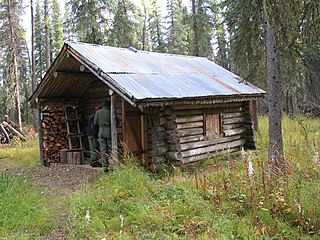
The Sushana Ranger Cabin No. 17, also known as the Sushana River Ranger Cabin and Sushana Patrol Cabin, is a log shelter in the National Park Service Rustic style in Denali National Park. The cabin is part of a network of shelters for patrolling park rangers throughout the park. It is a standard design by the National Park Service Branch of Plans and Designs and was built in 1932.

The Lower Toklat Ranger Cabin No. 18, also known as the Lower Toklat Patrol Cabin, is a log shelter in the National Park Service Rustic style in Denali National Park. The cabin is part of a network of shelters used by patrolling park rangers throughout the park. It is a standard design by the National Park Service Branch of Plans and Designs and was built in 1931. The cabin has twelve separate log dog kennels, also to a standard Park Service design.

Moose Creek Ranger Cabin No. 19, also known as Moose Creek Patrol Cabin and Moose Creek Shelter Cabin, is a log shelter in the National Park Service Rustic style in Denali National Park. The cabin is part of a network of shelters for patrolling park rangers throughout the park. It is a standard design by the National Park Service Branch of Plans and Designs and was built in 1935. The cabin has five separate log dog kennels, also to a standard Park Service design, as well as an elevated food cache.
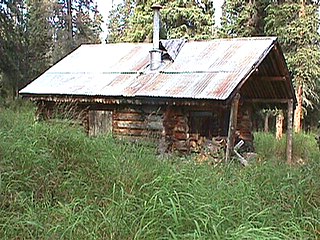
The Riley Creek Ranger Cabin No. 20, also known as Riley Creek Patrol Cabin, is a log shelter in the National Park Service Rustic style in Denali National Park. The cabin is part of a network of shelters for patrolling park rangers throughout the park. It is a standard design by the National Park Service Branch of Plans and Designs and was built in 1931.

Upper Toklat Ranger Station No. 24, also known as the Upper Toklat River Cabin is a log shelter in the National Park Service Rustic style in Denali National Park. The cabin is now part of a network of shelters for patrolling park rangers throughout the park. It is a standard design by the National Park Service Branch of Plans and Designs and was built in 1930. The cabin is one of five cabins originally built by the Alaska Road Commission to provide shelter to crews working on park roads. The Upper Toklat River cabin is centrally located and was a distribution point for supplies.

Igloo Creek Patrol Cabin No. 25 is a log shelter in the National Park Service Rustic style in Denali National Park. Originally built by the Alaska Road Commission, it was the site of a summer construction camp, and was used for supply storage. The cabin is now part of a network of shelters used by patrolling park rangers throughout the park. It is a standard design by the National Park Service Branch of Plans and Designs and was built in 1928.
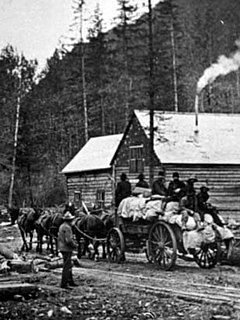
The Board of Road Commissioners for Alaska, more commonly known as the Alaska Road Commission or ARC, was created in 1905 as a board of the U.S. War Department. It was responsible for the construction and improvement of many important Alaska highways, such as the Richardson Highway, Steese Highway, Elliot Highway and Edgerton Highway, among others.
Architects of the National Park Service are the architects and landscape architects who were employed by the National Park Service (NPS) starting in 1918 to design buildings, structures, roads, trails and other features in the United States National Parks. Many of their works are listed on the National Register of Historic Places, and a number have also been designated as National Historic Landmarks.

The Ewe Creek Ranger Cabin No. 8, also known as Lower Savage River Cabin and Lower Savage Patrol Cabin, is a historic backcountry shelter in Denali National Park and Preserve. It is located 5 miles (8.0 km) downstream (north) from the park highway, on the banks of the Savage River. It is fashioned from peeled logs, with the gaps filled with moss, oakum, and chinking. The gable roof is corrugated metal. The cabin is one of four built by the National Park Service in the park in 1931. The cabin is used by rangers who patrol the park's backcountry.

The Lower Windy Creek Ranger Cabin No. 15, also known as Lower Windy Creek Patrol Cabin and Lower Windy Shelter Cabin, is a historic backcountry shelter in the Denali National Park & Preserve, in Alaska. It is built out of peeled logs, sealed with oakum and concrete chinking. It has a medium-pitch gable roof of corrugated metal and shiplap. The site includes seven log shelters for dogs, located about 70 feet (21 m) north of the cabin. The cabin is located about 500 feet east of Mile 324 on the Alaska Railroad.

The Toklat Ranger Station No. 4, also known as Pearson Cabin, is a log shelter in the National Park Service Rustic style in Denali National Park located near the main branch of the Toklat River at Mile 53.8, west of Park Road. It was listed on the National Register of Historic Places in 1986. It is a standard design by the National Park Service Branch of Plans and Designs and was built in 1927.






















